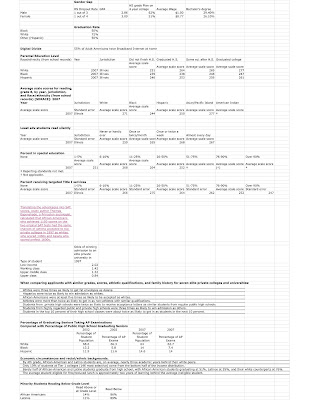The problem that I have encountered is that every single element of the Achievement Gap intertwines and intersects with each other. You can’t isolate any one factor, it is a never-ending rabbit hole and where does it end? The more I tried to refine the list of factors the more that it grew. Pretty much everything is a factor in the achievement gap.
Below is the brainstorm of ideas that are part of the Achievement Gap problem:
Some, but not all of the factors include: gender, race, parents’ education, parents’ income, books in the house, prenatal care, birth weight, and access to technology both in and out of school. These are just some of the many factors that effect a child’s achievement.
As I started to collect data, I began to put the information into a spreadsheet to try to make some sense of all the information. The problem is; how do you categorize each piece of information? Much of the statistical data does not seem to fit with each other. It's a jumble of separate pieces of information that seemed to not fit into a nice neat spreadsheet.
I keep trying to make some sense of all this data. I know that I haven't even scratched the surface as to the causes or factors of the Achievement Gap. But with all of this data how can I use it in my classroom to help the students that are falling behind? I know that in my own classroom I see firsthand many of these types of students that are falling behind. As a teacher, I know that myself and my colleagues are doing everything we can to close the gap, but it is an uphill battle. Often we feel alone in the trenches. There are so many things that we cannot control and an infinite amount of obstacles that exist even before the child enters our classroom.
As we talked in class I was asked what is the most important factor in the Achievement Gap? It was hard to put a finger on just one aspect. After our discussion in class and thinking about what are the most important factors I rated what I thought were the most important factors:
1. Mother’s education
2. Income
3. Race
4. Gender
5. Prenatal care (birth weight)
6. Household make-up/stability
7. Motivation
My conclusion is that with No Child Left Behind and schools trying to make AYP everyone is blaming the teachers for all of the troubles of our students while not wanting to address any of the other reasons for the Achievement Gap. We blame the teachers because it is easy. No one wants to point a finger at any of the other variables because it is too hard. It is impossible to isolate all (or any) of these factors so everyone likes to point a finger at teachers and make them the scapegoat in the Achievement Gap crisis.
It is easy to blame the messenger rather than look into the mirror. No one wants to admit their failures.
Here are some of the sources that I used:
http://en.wikipedia.org/wiki/Achievement_gap_in_the_United_States
http://www.edweek.org/rc/issues/achievement-gap/
http://nces.ed.gov/nationsreportcard/naepdata/variables.aspx
http://www.educationequalityproject.org/what_we_stand_for/achievement_gap







